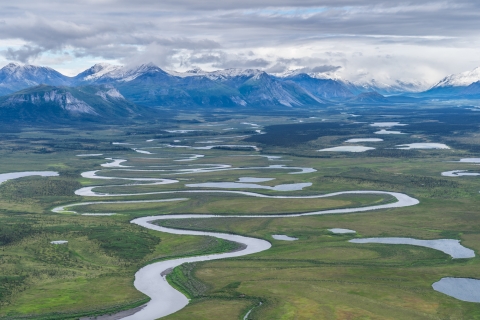Water is essential to life. Free-flowing rivers are the arteries of our landscapes, vital for maintaining thriving populations of fish, wildlife and people.
The Wild and Scenic Rivers Wild and Scenic Rivers
The Wild and Scenic Rivers Act of 1968 established the National Wild and Scenic Rivers System, and authorizes Congress to preserve certain rivers with outstanding natural, cultural and recreational values in a free-flowing condition for the enjoyment of present and future generations. The act is notable for safeguarding the special character of these rivers, while also recognizing the potential for their appropriate use and development. The act encourages river management that crosses political boundaries and promotes public participation in developing goals for river protection.
Learn more about Wild and Scenic Rivers Act of 1968 established the National Wild and Scenic Rivers System, protecting for future generations free-flowing waterways with extraordinary natural, cultural and recreational qualities. The system includes more than 220 rivers, and covers more than 13,400 miles of rivers and streams. Designation protects each river’s unique characteristics and water quality, while ensuring these treasured rivers are protected for people’s use and enjoyment into the future.
“…Our own children and grandchildren will come to know and come to love the great forests and the wild rivers that we have protected and left to them...”
— President Lyndon B. Johnson on signing the Wild and Scenic Rivers Act, October 2, 1968.
The National Wildlife Refuge System, managed by the U.S. Fish and Wildlife Service, contains 14 wild and scenic rivers, extending 1,066 river miles. The Service manages some of these rivers independently. It co-manages other waterways with other federal agencies, such as the Bureau of Land Management, the National Park Service and the U.S. Forest Service.
National Wildlife Refuges with Wild and Scenic Rivers
Many of the country's more than 560 national wildlife refuges contain wild and scenic rivers or stretches of them. Here are refuges and their corresponding wild and scenic rivers.
- Arctic National Wildlife Refuge, Alaska – Ivishak, Sheenjek, and Wind Rivers
- Cape May National Wildlife Refuge, New Jersey - Great Egg Harbor River (cooperatively managed with National Park Service)
- Charles M. Russell National Wildlife Refuge, Montana – Missouri River (cooperatively managed with Bureau of Land Management)
- Fort Niobrara National Wildlife Refuge, Nebraska – Niobrara River (cooperatively managed with National Park Service)
- Great Meadows National Wildlife Refuge, Massachusetts - Sudbury River (cooperatively managed with National Park Service, State of Massachusetts and local governments)
- Karl E. Mundt National Wildlife Refuge, South Dakota - Missouri River (cooperatively managed with National Park Service)
- National Elk Refuge, Wyoming – Gros Ventre River, Snake River Headwaters (cooperatively managed with National Park Service and U.S. Forest Service)
- Nowitna National Wildlife Refuge, Alaska – Nowitna River
- Oxbow National Wildlife Refuge, Massachusetts - Nashua River (cooperatively managed with National Park Service)
- Selawik National Wildlife Refuge, Alaska – Selawik River
- Silvio O. Conte National Wildlife Refuge, New Hampshire, Vermont, Massachusetts and Connecticut – Westfield River
- Yukon Delta National Wildlife Refuge, Alaska – Andreafsky River
- Yukon Flats National Wildlife Refuge, Alaska – Beaver Creek, Alaska (cooperatively managed with Bureau of Land Management)
As a visitor to wild and scenic rivers, you may thrill to the sight of wildlife thriving along river corridors, travel by boat through awe-inspiring scenery, appreciate places of cultural significance and history, or challenge yourself with a recreational adventure. You can help ensure that others have the same opportunities.
Local residents and adjacent landowners are vital partners in protecting wild and scenic rivers. They may regularly visit a river and have firsthand knowledge of its value and extraordinary characteristics. Everyone can help care for rivers!
Be a river steward by:
- Practicing “Leave No Trace” principles when visiting
- Engaging as a stakeholder in river management planning
- Enjoying and learning more about wild and scenic rivers, either in-person or through a virtual visit.
Learn more about the National Wild and Scenic Rivers System and designated rivers.





